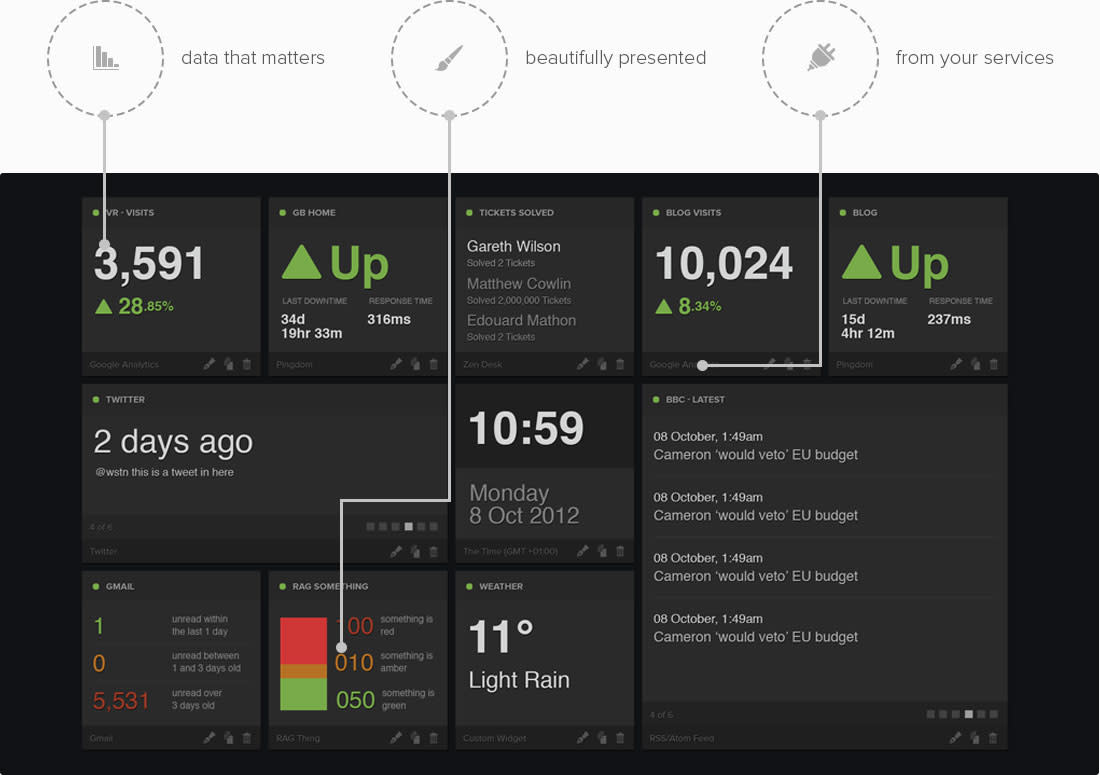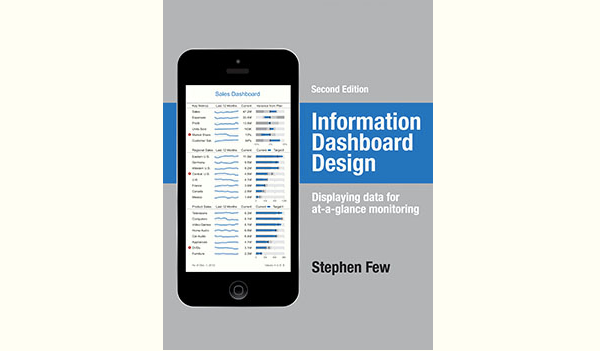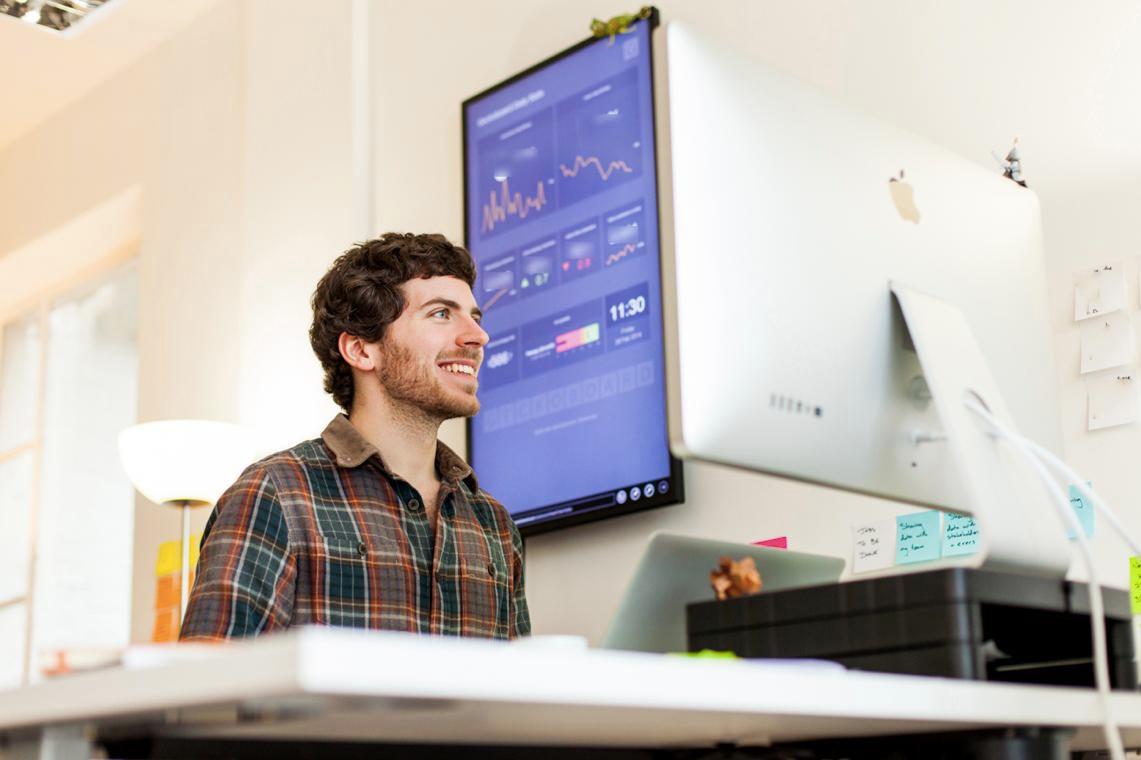Paul Joyce, the London entrepreneur behind Geckoboard, presents an alarming scene to show the value proposition of his startup's status board app.
"You're speeding down the road on the motorway and somebody just leapt across and obscured your dashboard," he says. "You know you're probably fine—you're in the speed limit, you're probably not about to run out of gas, your oil pressure's fine and you don't have any engine warning lights on."
Despite that intuition, however, most drivers caught in this situation are filled with panic, Joyce says.
"It would immediately make you slow down. It would make you less confident about where you are at this point in time and the decisions that you can make."
There's a strong analogy to be made between a dashboard's value to a driver and a status board's value to a business if you focus on the right metrics, Joyce says.
Geckoboard's product is a customizable status board that offers companies one place to see vital signs. From showing that day's paid sign-ups, churn and revenue numbers to presenting stats such as page views, referrals or organic search traffic, Geckoboard and startups like it, such as Ducksboard and Cyfe, make vital information quickly accessible and easily digestible.

So how does the maker of such a product use the product itself? What performance metrics does it display on its own status board? To learn just that and more, we recently spoke with Joyce, Geckoboard's co-founder and CEO.
How Geckoboard Uses Geckoboard
"We haven't actually spoken about how we use Geckoboard at Geckoboard," Joyce says at the start of our phone interview. Though his team showcases how their customers use status boards, before now they haven't gone on record to say how they themselves use the product.
Joyce's reason: "I'm not necessarily sure we're that representative of the types of companies that use Geckoboard." Though they have users among fellow startups, an increasing number of large organizations and enterprise companies have come to rely on Geckoboard. As those companies are at a significantly different lifecycle and phase in their development, Joyce hasn't seen a need to put his company's use of their own product on display.
But that didn't stop us at Zapier from prodding—really, how does Geckoboard use Geckoboard?
"We're probably in the very top percentile of number of Geckoboard users per head," Joyce says about his 16-person team. "That's because 'A', it's our own product and we're dogfooding all of the time, and 'B', we're trying to find new ways of using it."
Across the company, Geckoboard uses four status board:
One "main board" for all team members
One used by the growth team
Two shared by the engineering and product teams
"How many iterations has the main board in Geckoboard gone through?" Joyce asks himself out loud. "A lot. And a lot as we've become more sophisticated in understanding our metrics, our customers and their behavior. We've added things to it, (but) we've taken more things away," he says, stressing the importance of focusing on a limited number of metrics.
Geckoboard's Beginnings
Joyce came up with the idea for Geckoboard while designing and developing data warehouses for a bank. There, Joyce grew frustrated with the institution's limitations and what he knew was possible.
"It seemed to me that there was quite a large disconnect between where the data sat and the people that needed to make decisions based on that data," Joyce says. "The distance was in terms of complexity and in terms of time," noting that it could take months to add something to the warehouse. Moreover, the reports would come in the form of a spreadsheet or PDF, which would be either ignored or when examined, would be hard to interpret.
"What I thought was instead of going through these processes, is there space for a tool that does one thing very well and that's communicating data in an effective, timely manner in a way that human beings can understand easily? That was driving force behind starting to think about what would end up to be Geckoboard."
The idea originally came to him in March 2010, sparked by the release of a status board project by app creator Panic. Four months later, Joyce launched Geckoboard's alpha version.

"I think the moment that I knew that this would be interesting was I (when) put it up on Hacker News. 'This is what I've been working on, I'd love to hear any criticism, feedback,'" Joyce says. "We had about 850 people sign up that day…it was just a phenomenal reaction."
Soon, he began getting emails from businesses who wanted to use the tool, and before he knew it, he was spending five hours each night speaking to potential customers around the world. They were asking him: "When can we start paying you for it?"
In September 2010, Joyce handed in his notice at the bank and began working full-time on Geckoboard.
Early Metrics
Business dashboards are nothing new and Joyce is quick to point it out. In fact, he believes they're so common the term "dashboard" itself has been corrupted by the makers of enterprise tools.
"I really like the purity Stephen Few talks about—a glance-able, strategic dashboard that allows you to see where you are at the moment against your current goals and objectives and where you're heading," Joyce says. "Being able to do that allows you to firstly make better decisions because the decisions that you're making are based on the underlying data not opinions or gut reactions and data that's out of date."

Joyce also sees a status board as motivational. "As human beings we love to know what we're striving for, we love to have a cause and a mission and the clearer that can be the more powerful and incentive it is," he says. Putting the metrics on the wall makes people look and say, "Let's try and change them, up or down."
So if you had stepped inside the Geckoboard office in 2010, what metrics would you have seen up on their wall?
"We had vanity metrics on there early on, I'm going to hold my hand up and admit that," he says with a chuckle. "That was everything like how many beta sign-ups have we had, and how much has that grown over the last week."
Though you might see number of sign-ups as legitimate metric, Joyce calls it a "vanity metric" here because it wasn't applicable to his startup's goals. "I wasn't trying to optimize for number of beta sign-ups, I tried to optimize for people telling me 'yes,' this is something that they're willing to pay for," he says.
In reality, he goes easy on himself and other young entrepreneurs who are making an attempt to at least keep track of metrics at the start. Early on, he says, when you're still trying to find that product-market fit, there's only so much room for data and status boards.
"It is just simply about talking to customers and iterating and talking to customers," he says. "You're dealing with such low volume stuff looking at metrics and rates and whatever else can sometimes be a bit misleading."
Selecting the Right Metrics
If you feel you've arrived at the stage where it's time to put a status board up on your wall, Joyce would pose two questions. "Do you know how to chose the right metrics for where you are in your organization? If you know what those metrics are, the next question is: Can you get a hold of them?
"If you can do both of those things then you're likely to be a very long running customer of ours," Joyce says. "If one of those falls, then either you're not going to convert of you're going to churn pretty quickly."
He breaks down those two questions into four steps:
1. State Your Goals
"The very first question, before data comes into it, before anything comes into it is: Where are we and what are we trying to do? What are we trying to improve here? What is it that we're optimizing? Unless you can identify that, there's no point to do anything else," Joyce says.
If you choose the wrong metrics to share, those will leave an impression on your team, Joyce warns. "The danger with that is you're sending a signal: this is what's important to us as an organization, as a unit, this is what we're striving towards."
2. Identify Leading Metics
At Geckoboard, they keep tabs on leading and lagging metrics. "A lagging metric tells you about something that happens after the event, a leading metric is something that will give me an indication of how things will turn out," Joyce sums up.
Conversion rate, for example is a lagging metric because you're quantifying a customer event that happened in the past. Engagement, on the other hand, can be a leading metric because it can be correlated to another metric, such as conversions, you're trying to move.
That's the case at Geckoboard: "If we're looking to change conversion rate then we need to have a think back at what is activation, what does that mean and how do we find that out?" Joyce says, noting his team analyzes how current customers use their product, how they find success or meet dead ends, among other aspects.
3. Find What Impacts Leading Metrics
Once you've identified the leading metric, Joyce directs you to then ask yourself: How can we change that metric and do so in a way that incorporates data?
"It's about crunching through a process of trying to establish what are going to be the biggest changers or movers or biggest levers you can pull, how can you validate that as quickly as possible and move onto the next one with your learnings," Joyce says.
4. Check for "Yin and Yang" Metrics
"There's a lot of a talk about the one metric that matters, I actually prefer having yin and yang metrics," Joyce says. "If we are looking at conversion rate, we can do things now to materially increase our conversation rate, I know that for sure, but it might have a negative impact on churn. There's no point in just doing that in isolation, we need to take a holistic approach."
The 6 Metrics on Geckoboard's Board Today

Geckoboard's first iteration of its displayed status board focused on sign-ups. It's second board brought to the surface customer engagement with its app. The current board (above), which has been present in the startup's office for a few months now, prominently focuses on two metrics: conversion rate and churn.
"Those two metrics by themselves take up probably about 30 percent of the whole board. They are big, front and center," Joyce said.
Here's a look at the six metrics on Geckoboard's Geckoboard:
Conversion Rate and Churn
With revenues growing each month and venture capital investment of nearly $2 million, Geckoboard is concerned with the lagging metrics of conversion rate and churn (the percentage of paying customers canceling their accounts). But don't let that fool you that they don't keep an eye on leading metrics, too—that's the next one.
CHI (Customer Happiness Index)
Pulling a page from HubSpot's book, Geckboard has created its own CHI, a customer happiness index that measures a user's frequency and engagement with their app. They take four readings of customer CHI:
7-day CHI for free trial list
28-day CHI for free trial list
7-day CHI for paying customers
28- day CHI for paying customers
"We segment that out by trial users and cohorts of existing users so we can see, for example, people in our trial (in) this week's cohort are more engaged than last week's cohort. We know that that's a fairly solid indicator of conversion rate," Joyce says.
"If we notice from an individual customer's point of view that their CHI is going down, then we know that there's a good chance that they're going to churn. In aggregate, it allows us to see (if) we are doing anything in the round to help all of our customers."
MRR (Monthly Recurring Revenue) Growth
"One bullet graph that shows our MRR growth this month, but it's right down at the very bottom of the page," Joyce says.
Number of Paying Customers and Customers in Free Trial
He describes these last two as "small ones."
Staying Flexible

It's certain Geckoboard's displayed metrics will change over time, keeping a focus on what's presently important, Joyce says.
"The way we use data at Geckoboard is not about setting something in stone and leaving it at that, we're very flexible about what we're measuring, when we're measuring. It's about trying to align those two to our business goals at any given point in time."
And though Joyce can't point to specific metric that using a status board like Geckoboard will impact in an organization, he sees important outcomes in his own company. Weekly, and during some periods, daily, it creates a "water cooler effect" in the office.
"We'll see a couple of people just standing at the board, looking at it, talking about it, saying 'notice this,' asking questions about various things," he says. "We know that it helps in terms of being able to put (those metrics) front and center in people's minds."
Of course, Joyce is one of those people, too.
"I don't know how many times a day I look at it, but I know it's a lot," he says. "Just the same as I don't know how many times per journey I would look at my car dashboard, but it's probably a lot.
Credits: Images courtesy Geckoboard.
You might also enjoy this article: "From 0 to 100,000 Users in 4 Months: The Story Behind Productivity Chrome Extension Momentum"





